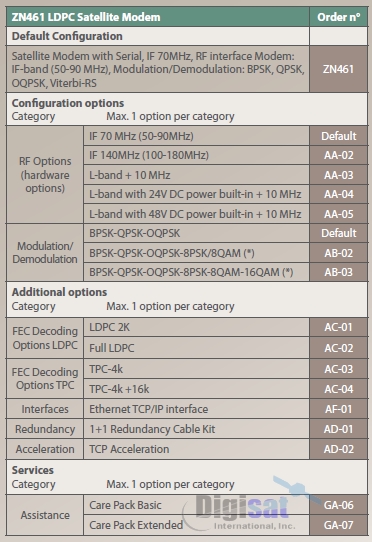Newtec Satcom Zenith Series LDPC IP Satellite Modem ZN461
Wide configuration flexibility, OPEX meets CAPEX, Efficiency meets value at low rates, Remote in-band management, Compatible with other modem manufacturers
ZN461 IP Satellite Modem
This product has reached end of life and is no longer available. Please contact us for a suitable replacement.
The highly advanced ZN461 is a brand new LDPC satellite modem designed for low to medium rate Internet Protocol applications over satellite. The modem typically addresses a large set of IP point-to-point or multi-point-to-point applications (e.g. enterprises, government and defense, DSNG, oil and gas, etc.) as from 1.2 kbps. As a default the ZN461 modem connects directly to terrestrial IP network infrastructures via serial connections or alternatively through an optional Ethernet interface.
The Zenith Series ZN461 modem comes with several hardware and software options which allow the operator to carefully select the modem configuration that perfectly fits the application. By flexibly changing the settings the satellite link efficiency can be optimized to the full.
Modulation Coding
The ZN461 supports Viterbi, Reed Solomon and Turbo coding options next to the advanced LDPC coding (Low Density Parity Code). In addition a large selection of code rates and block sizes are available. The LDPC implementation in the ZN461 provides the industry’s highest spectral efficiency and configuration flexibility to squeeze the most out of the satellite’s available bandwidth and spectral power, while keeping processing latency at the desired level.
RF Interface
At the output of the modem the signal is available on a 70MHz IF-band interface by default. L-band, 140 MHz IF-band as well as an internal BUC power supply and reference frequency are available as configuration options, providing a compact and cost effective solution.
Bandwidth Optimization
To further optimize the end-to-end performance of the ZN461 LDPC modem, standard functionality as Automatic Uplink Power Control (AUPC) and remote modem control can be multiplexed into the satellite carrier. The on board acceleration enhances TCP traffic over the link to boost throughput.

Key Features
![]() Extended LDPC with wide range of block sizes
Extended LDPC with wide range of block sizes
![]() BPSK/QPSK/OQPS/8PSK/8QAM/16QAM
BPSK/QPSK/OQPS/8PSK/8QAM/16QAM
![]() Data rates as from 1.2 kbps in both directions
Data rates as from 1.2 kbps in both directions
![]() Compatible FEC: Viterbi, TCM, Reed Solomon, TPC
Compatible FEC: Viterbi, TCM, Reed Solomon, TPC
![]() Serial and 10/100 Base-T Ethernet interfaces
Serial and 10/100 Base-T Ethernet interfaces
![]() Automatic Uplink Power Control (AUPC)
Automatic Uplink Power Control (AUPC)
![]() Fastest acquisition time: 71 ms at 64 kbps QPSK
Fastest acquisition time: 71 ms at 64 kbps QPSK
![]() Lowest latency: <15 ms at 64 kbps ¾ QPSK
Lowest latency: <15 ms at 64 kbps ¾ QPSK
![]() 10 MHz reference input/output
10 MHz reference input/output
![]() Standard 70 MHz IF-band (50-90 MHz)
Standard 70 MHz IF-band (50-90 MHz)
![]() 140 MHz IF-band (100-180 MHz)
140 MHz IF-band (100-180 MHz)
![]() L-band (Tx: 950-1750 MHz) (Rx: 950-1900 MHz)
L-band (Tx: 950-1750 MHz) (Rx: 950-1900 MHz)
![]() Internal BUC and LNB power (24v & 48v)
Internal BUC and LNB power (24v & 48v)
![]() On-board acceleration
On-board acceleration

|
||||||||||||||||||||||||||||||||||||||||||||||||||||||||||||||||||||||||||||
|
||||||||||||||||||||||||||||||||||||||||||||||||||||||||||||||||||||||||||||
|
||||||||||||||||||||||||||||||||||||||||||||||||||||||||||||||||||||||||||||
|
||||||||||||||||||||||||||||||||||||||||||||||||||||||||||||||||||||||||||||
|
||||||||||||||||||||||||||||||||||||||||||||||||||||||||||||||||||||||||||||
|
||||||||||||||||||||||||||||||||||||||||||||||||||||||||||||||||||||||||||||
IP Trunking, Enterprise, Oil & Gas, Maritime, Government & Defense, Satellite News Gathering (SNG), IP based cellular backhaul, Disaster Recovery, Emergency Communications


